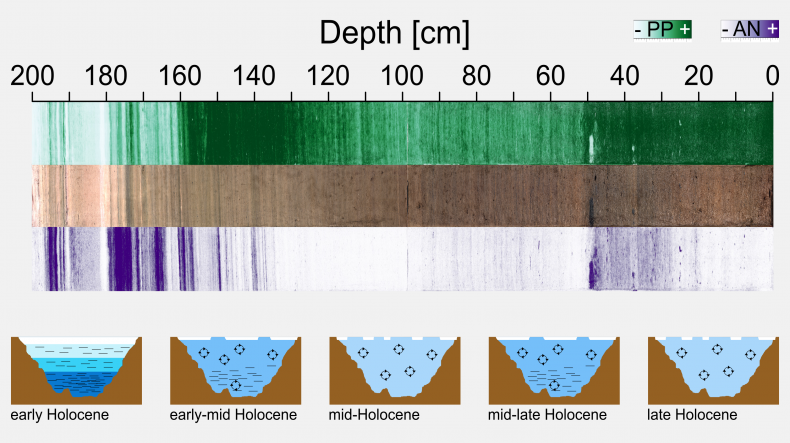The author(s) will give a talk
Sedimentary lipid biomarkers combined with novel hyperspectral imaging techniques: A multiproxy Holocene-length sedimentary reconstruction from Lake 578, S Greenland
1 Department of Geosciences, University of Massachusetts, Amherst
2 Department of Geosciences, University of Massachusetts, Amherst
3 Department of Geosciences, University of Massachusetts, Amherst
4 Department of Geosciences, University of Massachusetts, Amherst
5 Oeschger Centre for Climate Change Research, University of Bern, Switzerland
6 Department of Geosciences, University of Massachusetts, Amherst
Despite a remarkable range of climate reconstructions from ice cores and marine sediments, the de-glaciated “transition zone” between the Greenland ice sheet and the coast is still under-studied. Chronologically well-constrained climate reconstructions from lake sediments can contribute to the understanding of climate variability in these regions and further help elucidate Greenland's past climate variability. Furthermore, little is known about how lake systems in these regions responded to the local climate variability and how they have evolved over the Holocene.
Ice cover extent and duration on lakes can impact their mixing regimes and suppress holomictic events (full turn-over) leading to stratification and causing oxygen-depletion (anoxia) in the hypolimnion. Meromictic conditions further hamper the resuspension and recycling of nutrients deposited in the sediments to the upper (productive) water layers. In combination with reduced light conditions (ice and snow cover) and colder water temperatures this can limit the lacustrine primary productivity during extended ice-covered periods.
Hyperspectral imaging of lake sediments (HSI) is an emerging rapid technique employed to e.g., reconstruct the lake's trophic and anoxic states of the past at high spatio-temporal resolution. The relative absorption band depths measured at ?673 nm wavelength (RABD&sup673; indicative of semiquantitative green chloro-pigment concentrations) and at ?845 nm (RABD&sup845; presence of bacterio-pheophytins) can be used as proxies to semi-quantitatively reconstruct paleo-productivity and oxygen-depletion of the past, respectively.
Here, we present our results of a multiproxy investigation of a Holocene-length sedimentary sequence from Lake 578 (2 m long, obtained in August 2019), a postglacial lake from southern Greenland (61.08°N; 45.61°W, ~170 m a.s.l). Today it is a dimictic freshwater lake (spring-/fall turnovers) with a maximum depth of ~16 m.
Combining non-destructive hyperspectral and µXRF techniques with (destructive) lipid biomarker analyses allowed us to reconstruct Lake's 578 paleo-productivity and anoxia histories, as well as summer mean water temperatures over the Holocene, using branched glycerol dialkyl glycerol tetraethers (brGDGTs) as a paleothermometer.
K-means cluster analysis conducted on the proxies revealed five distinct clusters. The early Holocene sequence in Lake 578 (here ~11k – 9k cal yr BP) is characterized by lithogenic clay rich sediments. The lowest observed productivity in combination with peak values in anoxia-proxies suggest an extensively stratified water column (mero-/amictic conditions). The reconstructed brGDGT summer mean water temperature is the lowest during this period. Interestingly, short-term drops in reconstructed temperature are usually followed by delayed oxygen-depletion. We suggest that, during the early Holocene, Lake 578 was a proglacial lake-system dominated by extended ice cover causing a well-stratified water column.
Thereafter, the lithogenic proportion decreased and the sediments became more enriched in organic material showing that the lacustrine background sedimentation became more important (peak values at ~7.5 – 7k cal yr BP). Indeed, higher temperatures, and a decrease in anoxia-proxies indicate that the lake transformed into a postglacial system with less extensive ice-cover. Furthermore, fine laminations observed at the beginning of this sequence start to fade out. This points towards a better mixed lake system with more pronounced nutrient cycling. The productivity followed the temperature trend, indicating that temperature was the limiting factor during this phase. The period 6k – 3k cal yr BP is characterized by the warmest summer mean water temperatures, a well-mixed water column, and a decrease in productivity. This suggests that the productivity was no longer temperature-limited, but rather nutrient-limited.
After 3k cal yr BP, fine laminations in the sediments indicate a period of reduced holomictic events and hence, more extensive ice-cover, which is in line with a decrease in summer mean water temperature. A strong increase in productivity and anoxia observed at ~1.4 k cal yr BP points to an abrupt enhancement in nutrient-input. We hypothesize that this abrupt event was caused by a lake-level increase that submerged nutrient-rich soils adjacent to the lake (for further details please refer to the presentation of Zhao et al.).
The late Holocene sequence (~1.4k cal yr BP – present) is dominated by two distinct increases in mass accumulation rates between ~1000 – 800 cal yr BP and from ~1900CE to present, coinciding with the Norse settlements, and contemporary land use, respectively. While the productivity was only slightly enhanced during the Norse-period, peak values were observed after ~1960CE.
We provide the first hyperspectral imaging analyses of lake sediments from S Greenland and suggest that its application has great potential to rapidly reconstruct trophic- and anoxia histories of lakes on Greenland. Even though the preliminary chronology is not yet robust enough to pinpoint short-term climate fluctuations (e.g., 9.2k and 8.2k events), the proxy combination provided us with unique insights into the evolution of conditions in Lake 578.

Fig 1.
Holocene-length sediment sequence from Lake 578. Top: green-pigment distribution map, middle: true color-photo, bottom: bacterio-pheophytin distribution. 'PP': primary paleo productivity; 'AN': paleo anoxia. The pictograms represent simplified lake-stages over time.